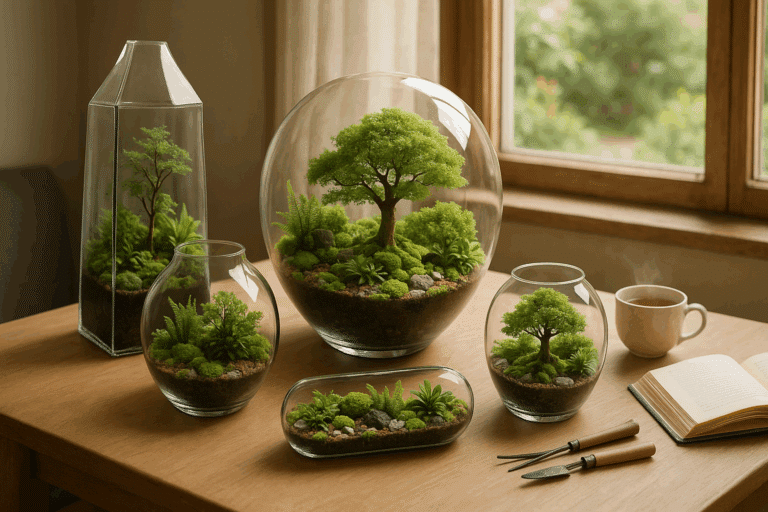Yet, for those living in urban settings, the prospect of growing one’s food can seem like a distant dream. Enter the Hydroponic Jar System. This innovative approach to indoor gardening is poised to revolutionize the way we grow plants, offering a practical solution to sustainability within our homes.

The Hydroponic Jar System is more than just a gardening trend. It’s a game-changer for those who believe in the power of green living but lack the outdoor space or suitable climate to maintain a traditional garden. This system allows individuals to cultivate fresh produce, free of pesticides, right in their living rooms, kitchens, or even bedrooms. As such, it’s an ideal solution for apartment dwellers, those living in colder climates, or anyone interested in exploring the frontier of indoor farming.
In the following sections, we will dive deeper into the specifics of this system – how it operates, the benefits it offers, and how it can contribute to a more sustainable future. Moreover, we will provide practical tips on setting up your hydroponic jar garden, ensuring that you’re well equipped to start your indoor farming journey. Growing fresh and green has never been this accessible. Embrace the revolution and embark on the path towards sustainability with our Hydroponic Jar System. 🌿🌱💧
The Science Behind Hydroponic Systems
Hydroponics is a revolutionary agricultural method that eliminates the need for soil, focusing instead on nutrient-rich water as the primary growth medium. The foundation of hydroponic science lies in understanding plant physiology—specifically, how plants absorb water and nutrients through their root systems. In a traditional soil-based environment, roots must work to extract nutrients from the soil, which can be inconsistent due to soil degradation, compaction, or pH imbalance. In hydroponics, the nutrients are already dissolved in water in an optimal balance, allowing the plant to absorb them directly with minimal effort and maximum efficiency.
This direct access to nutrients means that plants expend less energy searching for food and more on growth and fruit production. The result is faster-growing, more robust plants with potentially higher yields. Furthermore, hydroponics allows for complete environmental control—nutrient levels, light exposure, humidity, and pH can all be monitored and adjusted precisely. This makes hydroponic systems particularly appealing for indoor gardening and urban agriculture, where space, light, and natural soil are often limited.
From a scientific standpoint, hydroponics also facilitates experimentation and innovation. By adjusting variables like nutrient ratios or root oxygenation, growers can study plant behavior in controlled settings. It opens opportunities for research in food security, vertical farming, and closed-loop agriculture, especially valuable in areas with poor soil or limited water availability.
Another scientific advantage of hydroponic systems is their potential for sustainability. Traditional farming practices often result in significant water waste, runoff pollution, and soil depletion. Hydroponic systems use recirculating water, which drastically reduces waste—some systems use up to 90% less water than soil gardening. Moreover, the absence of pesticides and herbicides due to controlled environments reduces chemical exposure and environmental contamination.
Key Components of a Hydroponic Jar System (Expanded)
A hydroponic jar system is one of the most accessible forms of hydroponics, making it perfect for beginners, students, and casual home gardeners. While it may look simple, each element in the system plays a crucial role in supporting healthy plant growth.
1. The Jar
The jar acts as the reservoir for the water and nutrient solution. It is typically made of transparent or semi-transparent glass or plastic to allow observation of root development and water levels. However, excessive light can promote algae growth, which competes with plants for oxygen and nutrients. To combat this, many growers wrap their jars in opaque covers, paint them, or use tinted glass to block out unwanted light while still keeping an eye on the contents.
The jar’s size is another important factor. A jar that is too small may not provide enough room for root development, while a larger jar supports larger plants and reduces the frequency of refills. Quart- or half-gallon-size jars are typically ideal for growing leafy greens and herbs.
2. Growing Medium
In hydroponics, the growing medium doesn’t supply nutrients but provides physical support for the plant roots. It also helps retain moisture and allows for gas exchange (oxygen for the roots). Popular media for jar systems include:
- Rockwool: Made from spun volcanic rock, it retains moisture well and has a high air-to-water ratio.
- Clay pellets (LECA): Lightweight expanded clay aggregates that are pH neutral and reusable.
- Coconut coir: A sustainable, fibrous material made from coconut husks; it retains water and allows for excellent root aeration.
- Perlite or vermiculite: These mineral-based media help with drainage and moisture retention.
Choosing the right medium depends on the plant type and the size of the jar. For herbs and greens, coconut coir mixed with perlite provides an excellent balance of water retention and oxygenation.
3. Nutrient Solution
The nutrient solution is arguably the most important part of the hydroponic system. It provides all essential elements required for plant growth, including:
- Macronutrients: Nitrogen (N), Phosphorus (P), and Potassium (K), often referred to as NPK.
- Secondary nutrients: Calcium (Ca), Magnesium (Mg), and Sulfur (S).
- Micronutrients: Iron, Manganese, Boron, Zinc, Copper, and Molybdenum.
These nutrients are dissolved in water in specific concentrations. Pre-mixed hydroponic nutrient blends are available and are recommended for beginners. It’s crucial to monitor pH levels (ideally between 5.5 and 6.5) because nutrient uptake is highly pH-dependent. A digital pH meter or test strips can help maintain balance.
4. The Plant
While virtually any plant can be grown hydroponically, the jar system is best suited for compact plants with shallow roots. Ideal candidates include:
- Leafy greens: Lettuce, spinach, kale
- Herbs: Basil, cilantro, parsley, mint, dill
- Edibles: Green onions, microgreens, strawberries (in larger jars)
It’s best to start with seedlings or cuttings that have already developed roots. Seed starting in rockwool cubes or using a germination dome helps create a healthy foundation for hydroponic transition.
The Benefits of Indoor Gardening with Our Hydroponic Jar System
- Space Efficiency: Hydroponic systems, particularly jar-based ones, take up less space than traditional gardens. They can be set up anywhere, making them suitable for urban dwellers who lack outdoor space.
- Controlled Environment: Indoor hydroponics allows you to control the growth environment, including the temperature, light, and nutrient levels. This ensures optimal growth conditions for your plants.
- Sustainability: Hydroponic systems use significantly less water than soil-based gardening, making them more eco-friendly. Additionally, they do not require the use of pesticides, further reducing their environmental impact.
- Year-round Production: Indoor hydroponics eliminates the seasonal restrictions of outdoor gardening, allowing for year-round plant production.

Setting Up Your Hydroponic Jar System (Expandido)
Setting up your Hydroponic Jar System is simple and straightforward, making it accessible even for gardening novices. Begin by selecting a clear or tinted jar that’s large enough to comfortably accommodate your plant’s root system while leaving space for water circulation. A jar size of 1 to 2 liters is typically ideal for herbs and leafy greens.
Next, choose a growing medium that suits the type of plant you’re cultivating. Rockwool cubes are excellent for starting seeds and offer excellent water retention, while clay pellets (LECA) provide better aeration and are reusable. Coconut coir, being eco-friendly and biodegradable, is a great sustainable option with excellent water-holding capacity.
After the growing medium is set, prepare your nutrient solution by mixing hydroponic nutrients into filtered or distilled water. Follow the manufacturer’s guidelines carefully to ensure proper balance of macronutrients (N-P-K) and micronutrients. Use a pH testing kit or digital meter to adjust the solution to a pH level between 5.5 and 6.5—this is critical for nutrient uptake.
Finally, place your plant seedling into the medium and lower it into the jar so the roots contact the nutrient-rich water. Ensure the jar is positioned in an area with adequate lighting, or use LED grow lights for consistent results.
Maintenance and Care
Maintaining a Hydroponic Jar System is relatively easy. Regularly monitor the nutrient solution’s pH and nutrient levels, and make necessary adjustments. Ensure the plants receive adequate light, either from a natural source or artificial grow lights. Regularly check for signs of plant disease or nutrient deficiency and take appropriate action.
Revolutionizing Indoor Gardening for a Sustainable Future
The Hydroponic Jar System is revolutionizing indoor gardening, making it more accessible, sustainable, and intelligent than ever before. By bypassing the limitations of traditional soil-based gardening, it offers an efficient and eco-friendly way to grow fresh, vibrant produce regardless of location, season, or available land. In a world where food insecurity and environmental challenges are on the rise, this solution emerges as both timely and transformative.
Whether you’re a city dweller with limited outdoor space or someone seeking a more sustainable gardening solution, the Hydroponic Jar System caters to all. It brings the garden indoors—right onto your windowsill, kitchen counter, or office desk—allowing you to grow a variety of nutrient-rich herbs and vegetables from the comfort of your home. The simplicity of the system also removes common barriers to entry, welcoming even complete beginners to experience the joy of growing their own food.
From a sustainability perspective, the benefits are numerous. Hydroponics uses up to 90% less water than traditional gardening methods, a crucial feature in areas facing water scarcity. Additionally, because there’s no soil involved, there’s no risk of soil-borne pests or diseases—eliminating the need for pesticides and harmful chemicals. This also drastically reduces environmental impact while promoting healthier, more organic produce.
The Hydroponic Jar System encourages local food production, reducing dependency on long supply chains and minimizing food miles. Fewer trucks on the road means fewer emissions, and fresher food reaching your plate faster. Moreover, for families and educators, it becomes a teaching tool—an opportunity to instill a love for science, sustainability, and health from a young age.
By investing in our Hydroponic Jar System, you’re not just growing plants; you’re cultivating a greener and more mindful future. You’re joining a growing movement of conscious consumers who value resource efficiency, food transparency, and environmental stewardship.
Conclusion
In conclusion, our Hydroponic Jar System is undeniably a game-changer in the realm of indoor gardening. It’s not just a passing trend but a vital part of a broader revolution—one that is reshaping the future of food, sustainability, and urban living. The system’s capacity to cultivate fresh and green produce indoors without the need for soil, pesticides, or vast acreage positions it at the cutting edge of innovation. As more households adopt this method, we move closer to a world where everyone has access to clean, local, and affordable produce.
This system empowers people to take control of their food supply, to grow with intention, and to foster healthier lifestyles. It transforms passive consumption into active participation, nurturing both plants and purpose. As you engage with the process—from germination to harvest—you develop a deeper awareness of natural rhythms and an appreciation for where your food comes from.
Moreover, the Hydroponic Jar System fosters a powerful connection between people and the planet. By greening your home, you reduce your carbon footprint, conserve water, and contribute to a more resilient food system. It’s an act of both personal empowerment and planetary care.
Imagine a future where every home has a green corner, where herbs grow next to your spice rack and salad greens are harvested before dinner. That future is within reach—and it starts with one jar, one seed, and your willingness to make a change.
Indeed, the Hydroponic Jar System isn’t merely about growing plants; it’s about cultivating change. In the era of environmental consciousness and rapid urbanization, this system symbolizes hope, empowerment, and action. It provides a simple yet powerful means to contribute to the global green movement, all while enhancing your quality of life.
So, let’s embrace this sustainable shift. Let’s reimagine our homes as green sanctuaries of nourishment, innovation, and inspiration. Together, through hydroponic indoor gardening, we can make our homes greener, our meals healthier, and our future undeniably brighter. 🌱💧🌍



